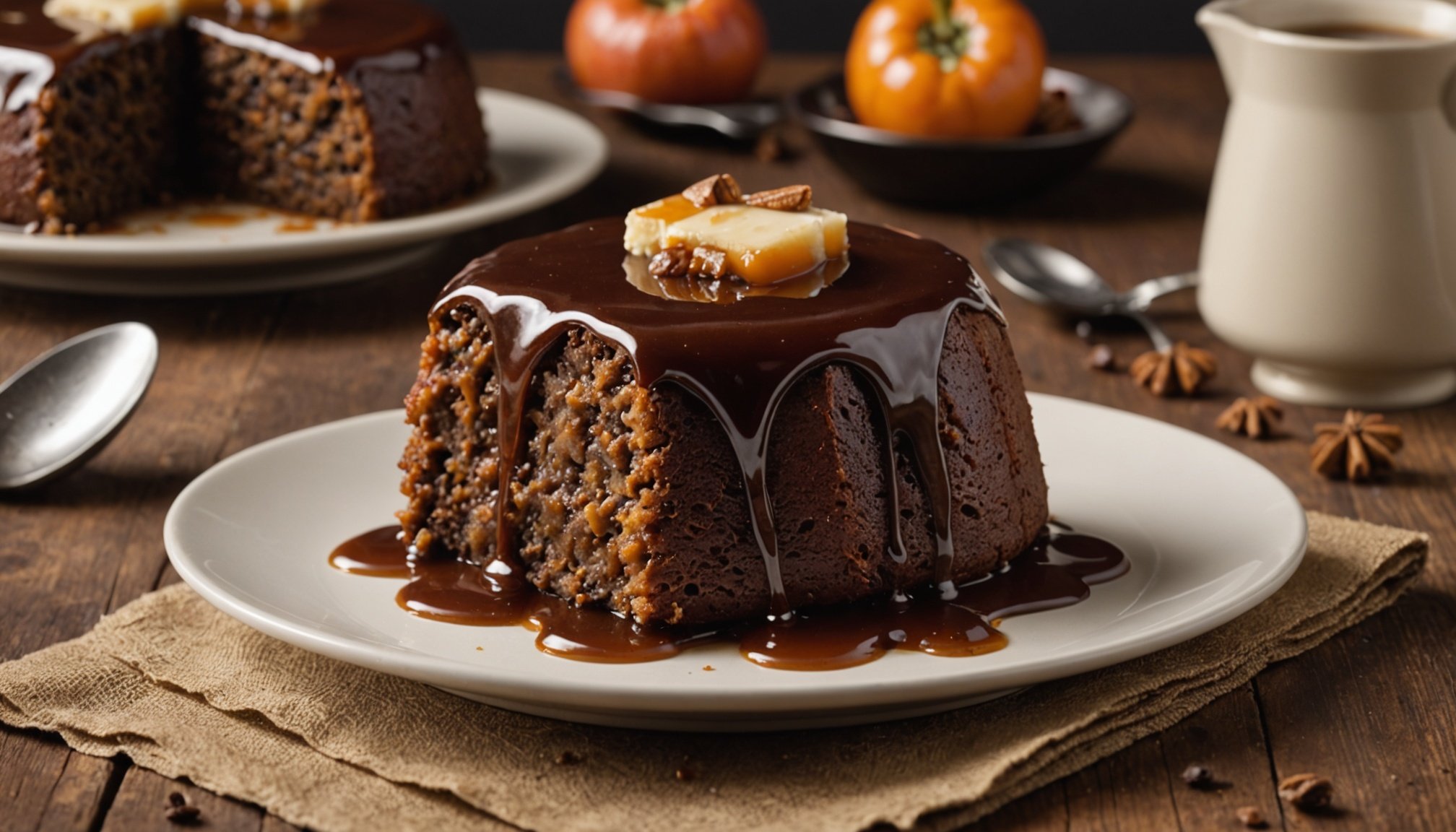Understanding Sticky Toffee Pudding
Sticky Toffee Pudding is a beloved staple in British cuisine, with a rich history that has seen it become a favourite dessert among many. Its origins are often debated, but it is generally agreed that it gained popularity in Britain during the 20th century. This dessert is known for its moist sponge, rich toffee sauce, and distinctive use of dates.
The ingredients for sticky toffee pudding are straightforward yet essential for achieving its classic taste. The traditional recipe includes dates, which provide a natural sweetness and moistness. This is combined with a decadent toffee sauce made from butter, cream, and brown sugar. Together, these create the pudding’s signature sticky texture and deep flavour.
This might interest you : Becoming a culinary expert in the uk: your 2024 guide to mastering cooking
Culturally, sticky toffee pudding holds a nostalgic place in British hearts and is often found in pubs and restaurants across the UK. Its comforting flavours and hearty texture make it a popular choice for a sweet ending to a meal. Understanding this dessert’s historical significance and traditional ingredients is essential for anyone wishing to recreate or innovate on it.
Essential Ingredients for Perfect Sticky Toffee Pudding
Sticky Toffee Pudding derives its remarkable taste and texture from a few key ingredients. At the heart of the traditional recipe are dates, which provide the pudding with its all-important moistness and natural sweetness. Opting for high-quality, ripe dates ensures a depth of flavor that’s difficult to match. Additionally, the toffee sauce, made with butter, cream, and brown sugar, contributes to the pudding’s luxurious sticky texture.
Also to read : Discover the Secret to Crafting a Rich and Robust Beef and Ale Pie
Sourcing high-quality sugars is crucial, as they influence the dessert’s flavor profile. Rich and unrefined brown sugars enhance caramel notes, adding complexity to the sauce. Meanwhile, using fresh, unsalted butter will yield creamier and more balanced tones.
For those with dietary restrictions, there are alternatives to explore. Almond milk or coconut cream can replace traditional cream for a dairy-free version, while gluten-free flour blends can substitute regular flour without significantly altering the texture.
Ultimately, it’s these ingredients and substitutions, carefully selected and proportioned, that define the quintessential Sticky Toffee Pudding experience. They lay a foundation for successful preparation and, most importantly, an indulgent dessert delight.
Step-by-Step Recipe for Sticky Toffee Pudding
Creating a perfect Sticky Toffee Pudding involves understanding precise baking instructions, starting with gathering the right ingredients. Ensuring you have fresh, high-quality dates is crucial for a pudding that is both sweet and moist. Additionally, select your sugars and butter with care to enhance the dessert’s flavour.
Gathering Your Ingredients
Begin by assembling your dates, flour, butter, sugar, and cream. Precision is key; measure ingredients accurately to maintain a balanced flavour. It’s recommended to soak dates in boiling water to soften them, enhancing their natural sweetness.
Preparing the Batter
Creating the batter requires a gentle touch. Mix softened dates with flour and baking powder, and combine them with a buttery sugar mixture. Achieving the right consistency is crucial, relying on precise mixing methods to evenly distribute the ingredients.
Baking Techniques
The right temperature ensures the dessert’s sticky texture. Bake at a moderate temperature for about 30-35 minutes. Avoid overbaking, which can lead to a dry pudding. Keep an eye on the surface; a rich caramel colour indicates readiness. This attention to detail throughout the preparation process ensures a superb final product.
Enhancing Flavor and Presentation
Sticky Toffee Pudding’s flavor can be elevated with thoughtful enhancements. Consider incorporating spices such as cinnamon or nutmeg, or adding chopped nuts for a textured richness. These additions create deeper flavor profiles, complementing the pudding’s inherent sweetness.
For serving, sauces and creams can dramatically influence the dessert experience. A drizzle of warm toffee sauce or a dollop of lightly whipped cream can transform each bite into a luxurious treat. It’s not just about taste but also how these components come together on the plate.
Presentation matters too. Aim for a visually appealing setup by using simple yet effective plating techniques. Consider these tips:
- Use a small amount of sauce to create a swirling effect around the pudding.
- Top with a few chopped nuts or a sprinkle of powdered sugar for contrast.
- Serve on a warm plate to maintain its texture and warmth.
These details not only enhance the dining experience but also showcase the pudding’s charm. Engaging the senses of sight, smell, and taste ensures that Sticky Toffee Pudding is a delightful finale to any meal.
Variations of Sticky Toffee Pudding
Sticky Toffee Pudding, though rooted in tradition, offers delicious variations for everyone to enjoy. Exploring recipe variations allows enthusiasts to experiment with unique takes and ingredient swaps, catering to diverse diets and preferences. One popular adjustment is a vegan adaptation, swapping butter and cream with plant-based alternatives like coconut oil and soy cream. This version ensures no compromise on richness while appealing to those avoiding animal products.
For a gluten-free twist, substituting regular flour with almond or oat flour maintains the classic texture. It’s crucial to blend different gluten-free flours to prevent a dense result. Regional variations are also popular; some might incorporate local ingredients like whisky-soaked raisins for a boozy kick or add a sprinkle of sea salt to balance sweetness.
Experimenting with spices or incorporating unique nuts like hazelnuts or pecans can further transform this classic. The key is balancing these new flavours while retaining the dessert’s quintessential essence. By boldly experimenting with flavors, baking enthusiasts can create delightful renditions, expanding sticky toffee pudding’s appeal across various palates while ensuring its signature charm.
Troubleshooting Common Issues
Making Sticky Toffee Pudding can be delightful, but common baking problems may arise, requiring quick solutions. A frequent issue is dryness, often due to overbaking or incorrect ratios. Ensure the right oven temperature is maintained; use an oven thermometer for accuracy. If dryness persists, slightly increase the butter or sugar content in the batter.
Sogginess may occur if the pudding is underbaked or the batter is too wet. To rectify this, verify mixing methods to avoid excessive liquid and adjust baking times appropriately. Similarly, flavour imbalance, particularly if too sweet, can be corrected by choosing less sugary varieties or reducing sugar in the toffee sauce.
Storing leftovers requires cool, airtight conditions to prevent the dessert from going stale. For reheating, gently warm the pudding in the oven wrapped in foil or microwave incrementally to avoid over-drying.
Remember, the key to troubleshooting lies in understanding the baking process and balancing each element’s role. By recognising these tips, any baking enthusiast can confidently tackle recipe solutions, ensuring a perfectly indulgent sticky toffee experience.








